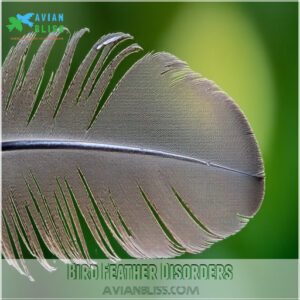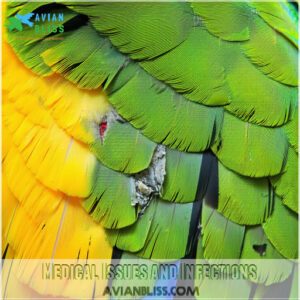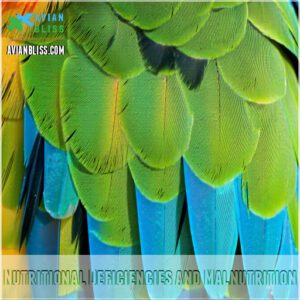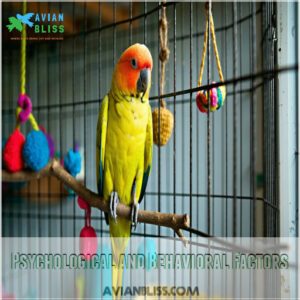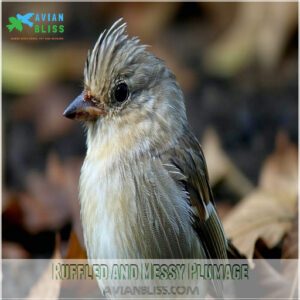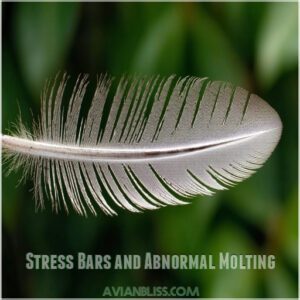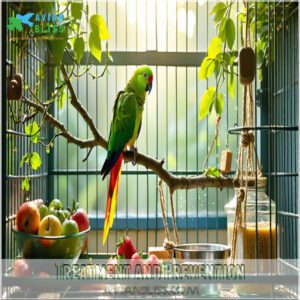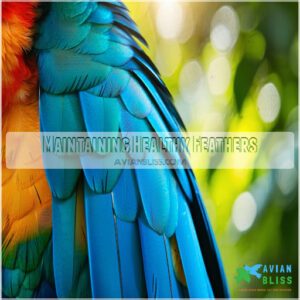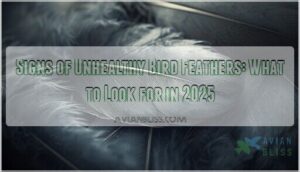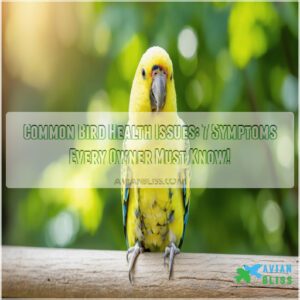This site is supported by our readers. We may earn a commission, at no cost to you, if you purchase through links.
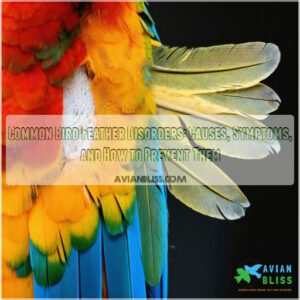 Common bird feather disorders can affect your feathered friend’s health and appearance.
Common bird feather disorders can affect your feathered friend’s health and appearance.
Feather cysts, caused by improper growth, may create lumps that vets often remove surgically.
Behavioral issues like plucking stem from stress, boredom, or skin irritation, while Psittacine Beak and Feather Disease (PBFD) is a serious viral condition that stunts feather growth and stresses the immune system.
Infections, whether fungal, bacterial, or parasitic, also damage feathers and irritate skin.
Poor nutrition, especially Vitamin A deficiencies, leads to brittle feathers and dull plumage.
Regular check-ups, a clean environment, and a balanced diet help protect against these common bird feather disorders, promoting overall health and well-being.
Table Of Contents
- Key Takeaways
- Bird Feather Disorders
- Causes of Feather Loss
- Symptoms of Feather Disease
- Treatment and Prevention
- Maintaining Healthy Feathers
- Frequently Asked Questions (FAQs)
- What are the most common health problems seen in pet birds?
- What causes loss of feathers & skin disorders?
- What are backyard bird diseases?
- Can a bird lose feathers?
- Is feather loss fatal?
- What causes psittacine beak and feather disease?
- What is the disease from bird feathers?
- What does a feather cyst look like?
- What do unhealthy bird feathers look like?
- What are the symptoms of feather disease in birds?
- Conclusion
Key Takeaways
- Keep your bird’s feathers healthy with a balanced diet rich in Vitamin A, regular vet check-ups, and a clean, stress-free environment.
- Watch for signs of issues like dull or brittle feathers, stress bars, abnormal molting, or feather cysts to catch problems early.
- Feather plucking is often caused by stress, boredom, or infections, so enrich your bird’s environment and address underlying health issues.
- Psittacine Beak and Feather Disease (PBFD) is a serious viral condition that weakens the immune system and damages feathers; there’s no cure, so prevention is key.
Bird Feather Disorders
Bird feather disorders, such as feather cysts, plucking, and viral diseases, can impact both a bird’s health and well-being.
Understanding the causes and signs helps you take steps to protect your feathered companion from these common issues.
Feather Cysts and Plucking
Feather cysts and plucking can be serious issues for birds, causing discomfort and feather damage. Cysts occur when feathers can’t grow properly, leading to follicle issues.
Plucking behavior often stems from stress or skin conditions.
To help your bird:
- Provide a balanced diet to prevent feather inflammation.
- Create mental stimulation to reduce feather destructive behavior.
- Seek veterinary care for abnormal feathers.
Psittacine Beak and Feather Disease
Psittacine Beak and Feather Disease (PBFD) wreaks havoc on birds’ health.
This viral transmission causes feather loss, lesions, and beak deformity.
PBFD is caused by a small DNA virus called BFDV.
Abnormal feathers, such as stunted or fragile ones, signal infection.
| Symptom | Effect |
|---|---|
| Feather Lesions | Fragile, abnormal feathers |
| Beak Deformity | Cracks, elongation |
| Immune Suppression | Secondary infections result |
Disease diagnosis involves blood tests.
Sadly, there’s no cure.
Infectious Feather Conditions
Bird feathers can suffer from infections caused by avian pathogens like fungal infections, bacterial diseases, or parasitic infestations.
These feather infections irritate skin, damage feathers, and sometimes lead to systemic illness. Viral outbreaks, like Psittacine beak and feather disease, often cause lasting harm.
Feather plucking in pet birds can be a sign of underlying medical issues.
Effective parasite control, clean environments, and timely treatment for bacterial infections or fungal infections can greatly protect your bird’s feathers and health.
Causes of Feather Loss
Feather loss in birds can happen due to medical issues, infections, nutritional deficiencies, or behavioral problems.
Understanding these causes helps you identify potential triggers and take steps to protect your bird’s health.
Medical Issues and Infections
When medical problems strike, feathers show it first.
Viral infections like Psittacine beak and feather disease or avian pox, bacterial infections, fungal conditions, and parasite infestations can wreak havoc on plumage.
Common culprits include:
- Bacterial diseases leading to feather folliculitis.
- Fungal infections causing respiratory and skin issues.
- Parasitic infestations triggering irritation.
- Viral threats disrupting feather growth entirely.
Nutritional Deficiencies and Malnutrition
Poor diets often cause nutritional deficiencies, impacting feather quality and leading to feather loss.
Malnutrition effects include dull feathers, brittle shafts, and skin problems. Vitamin A, key for healthy folicles, often lacks in seed-heavy diets.
Calcium imbalances disrupt growth and overall health.
Avian vets recommend preventative care visits to catch potential problems early.
To meet dietary needs, offer diverse foods ensuring nutrient balance, like pellets, veggies, and sunlight-exposure for vitamin D to support overall healthy folicles.
Psychological and Behavioral Factors
Stress and behavioral issues often trigger feather plucking, a frustrating feather picking disorder.
Environmental stress, like loud noises or tight spaces, can amplify psychological causes.
Birds experiencing boredom or lacking social bonding may develop feather destructive behavior as a coping mechanism.
Addressing stress factors involves enriching their environment, improving interactions, and ensuring your feathered friend feels secure, engaged, and mentally stimulated.
Symptoms of Feather Disease
You can identify signs of feather disease by observing changes like dull coloration, breakage, and messy plumage.
Stress bars, abnormal molting, or persistent feather loss may also point to underlying health issues, which can be considered a sign of feather disease.
Dull Coloration and Breakage
Feather discoloration and breakage often indicate underlying issues.
Fading or brittle plumage isn’t just cosmetic—it’s a health clue.
Causes include:
- Nutritional Deficiencies: Lack of vitamin A impacts feather pigmentation.
- Environmental Stress: Low humidity worsens feather damage.
- Feather Wear: Over-preening leads to dull feathers.
- Infections: Parasitic or fungal conditions weaken feathers, causing breakage and color loss.
Ruffled and Messy Plumage
Ruffled and messy plumage often signals unhealthy feathers, like dull coloration.
Poor feather texture can indicate underlying issues such as infections, malnutrition, or feather destructive behavior.
Watch for clumped or tangled feathers, bent shafts, or feather damage.
| Symptom | Possible Cause |
|---|---|
| Feather loss | Nutritional deficiency |
| Feather plucking | Stress or boredom |
| Feather discoloration | Malnutrition |
| Beak health issues | Vitamin imbalance |
Plumage care is essential for healthy molting patterns and can help prevent issues related to malnutrition.
Stress Bars and Abnormal Molting
Ever noticed faint horizontal lines on your bird’s feathers? These are stress bars, signs of interrupted feather growth due to factors like illness or malnutrition.
Meanwhile, abnormal molting throws off their molting rhythm, leading to uneven feather regrowth. Understanding the molting bird process is essential for identifying these issues.
Keep an eye out for:
- Bald patches or irregular molting patterns
- Feather breakage or weak texture
- Hormonal or nutritional imbalances
- Behavioral changes indicating stress.
Treatment and Prevention
You can help your bird recover from feather disorders by treating underlying medical issues and following your veterinarian’s advice.
Prevention involves creating a stress-free environment, providing a balanced diet, and ensuring regular check-ups to maintain healthy feathers, which is crucial for overall well-being and can be considered as a form of prevention.
Surgical Removal of Feather Cysts
When feather cysts develop, surgical care by an avian veterinarian is essential.
Cyst removal involves excising the affected follicle to prevent recurrence. Non-surgical options, like draining, often fail long-term.
Skilled feather surgery improves avian health but requires post-operative care, like antibiotics, to minimize infection.
With prompt interventions, serious feather problems are avoidable, ensuring your bird’s comfort and healthier plumage.
Addressing Underlying Medical Issues
After removing feather cysts, focus on medical diagnosis to address underlying issues.
Health exams help spot conditions like bacterial infections, parasitic infections, or avian diseases.
For specific product options, consider exploring available bird infection treatment products.
Internal organ diseases, such as liver or kidney problems, often contribute to feather loss.
Quick veterinary care prevents worsening, and remember, untreated feather infections can lead to pain, so prioritizing timely treatment guarantees your bird’s comfort.
Environmental Enrichment and Stress Reduction
Improving your bird’s well-being starts with reducing stress and offering enriching experiences.
Consider providing bird stress reduction toys for your feathered friend.
Try these tips for a happier pet:
- Optimize Cage Design for space and stimulation.
- Provide Natural Light and good Air Quality for health.
- Encourage Social Interaction with toys or time outside the cage.
- Use Calming Techniques like soft music to ease feather destructive behavior and promote stress management.
These steps can help create a more nurturing environment, focusing on enriching experiences to ensure your bird leads a happy and healthy life.
Maintaining Healthy Feathers
You can keep your bird’s feathers healthy by focusing on good nutrition, regular check-ups, and a stress-free environment.
Consistent mental stimulation and physical activity also play a critical role in preventing feather problems.
Regular Veterinary Check-ups
Staying proactive with veterinary care can prevent feather problems before they escalate.
Regular bird exams let an avian veterinarian perform health screens, feather checks, and diagnostic tests.
These visits help identify hidden issues, ensuring healthy feather health.
| Check Type | Frequency | Purpose | Examples |
|---|---|---|---|
| Physical Exam | Twice yearly | General health overview | Weight, posture |
| Feather Checks | Twice yearly | Identify abnormalities | Molting patterns |
| Health Screens | Annually | Rule out hidden illnesses | Bloodwork, parasite testing |
| Diagnostic Tests | As needed | In-depth condition analysis | X-rays, biopsies |
These checks are crucial for maintaining the overall well-being of birds, and should be conducted by a qualified avian veterinarian to ensure accurate assessments and effective treatments.
By following this regular check-up schedule, bird owners can help prevent feather problems and ensure their pets lead happy and healthy lives.
Balanced Nutrition and Hydration
Good nutrition isn’t just a luxury—it’s essential for healthy feathers.
Consider necessary bird vitamin supplements for best feather health.
Provide a balanced bird nutrition plan with Vitamin Balance and omega-3 for feather strength.
Avoid Nutrient Deficiency by offering a varied, Healthy Diet.
Hydration Tips? Always make sure Water Quality is excellent.
Nutritional deficiencies often cause feather problems, so focus on high-quality food and clean water for vibrant plumage, ensuring overall Healthy Diet.
Providing Mental Stimulation and Exercise
Keeping your bird mentally sharp helps prevent feather problems and behavioral issues like feather picking disorder.
Stressful situations can lead to feather plucking behavior.
Engage your pet with:
- Toys and Puzzles for brain challenges.
- Foraging Activities like hiding treats.
- Flight Exercise, offering space for movement.
- Social Interaction to reduce loneliness.
Switch up environments regularly to promote curiosity and joy, ensuring lasting enrichment and health.
Frequently Asked Questions (FAQs)
What are the most common health problems seen in pet birds?
Picture your bird’s vibrant feathers fading, or it picking at itself non-stop.
Common health issues include feather plucking, infections like PBFD, nutritional deficiencies, and stress-related behaviors.
Veterinary care and ideal environments help prevent these common health issues.
What causes loss of feathers & skin disorders?
Feather loss and skin disorders in birds result from infections, hormonal imbalances, parasites, malnutrition, or stress.
Environmental factors like low humidity or extreme temperatures, combined with behavioral issues like plucking, often contribute to these conditions.
What are backyard bird diseases?
Backyard birds can carry diseases like avian influenza, salmonella, and aspergillosis.
These spread via droppings, feathers, or contaminated water.
Keep feeders clean, provide fresh water, and avoid overcrowding to reduce risk.
Can a bird lose feathers?
When birds lose feathers, it’s not always natural molting.
Illness, stress, malnutrition, or infections could be the culprit.
Watch for bald spots or abnormal molting and consult a veterinarian to uncover underlying issues.
Is feather loss fatal?
Feather loss isn’t usually fatal, but underlying causes like infections, malnutrition, or diseases can be serious and life-threatening if untreated.
Always seek a vet’s help to pinpoint the problem and protect your bird’s health.
What causes psittacine beak and feather disease?
Let’s blame a sneaky virus, shall we?
Psittacine Beak and Feather Disease (PBFD) is caused by a circovirus.
It spreads through direct contact, contaminated surfaces, or feather dust, damaging feathers and weakening immune systems.
Damaging feathers and weakening immune systems are critical aspects of the disease.
What is the disease from bird feathers?
Breathing in particles from bird feathers can expose you to diseases like Psittacosis, caused by Chlamydia bacteria.
It spreads through dried feces or feather dust, causing flu-like symptoms.
Always handle birds and cages with care.
What does a feather cyst look like?
Imagine a small lump forming on a bird’s skin.
That’s often a feather cyst.
It appears like a swollen, oval bump under the skin, sometimes yellowish, where a feather fails to emerge properly.
What do unhealthy bird feathers look like?
Unhealthy feathers often appear dull, brittle, or discolored.
You might notice stress bars, abnormal molting, or messy plumage.
Watch for thinning, bald patches, or ragged edges—these all signal underlying health or environmental issues.
What are the symptoms of feather disease in birds?
Birds with feather diseases show symptoms like feather loss, dull or broken plumage, pigment changes, abnormal molting, or cysts.
Watch for stress bars, messy patterns, or swelling.
Timely care keeps them healthy and happy!
Conclusion
Approximately 10% of pet birds develop common bird feather disorders during their lives, making awareness essential for owners.
Recognizing conditions like feather cysts, plucking, or PBFD early can prevent complications.
You can protect your bird by ensuring a clean environment, providing a balanced diet rich in Vitamin A, and scheduling regular vet check-ups.
Watch for symptoms such as dull feathers, abnormal molting, or stress bars, and take a proactive approach to promote your bird’s health, keeping its plumage vibrant and intact.
- https://www.merckvetmanual.com/bird-owners/disorders-and-diseases-of-birds/skin-and-feather-disorders-of-pet-birds
- https://en.wikipedia.org/wiki/Psittacine_beak_and_feather_disease
- https://www.dcceew.gov.au/environment/invasive-species/diseases-fungi-and-parasites/beak-and-feather-disease
- https://pmc.ncbi.nlm.nih.gov/articles/PMC6097735/
- https://www.cdc.gov/pneumonia/atypical/psittacosis/index.html

